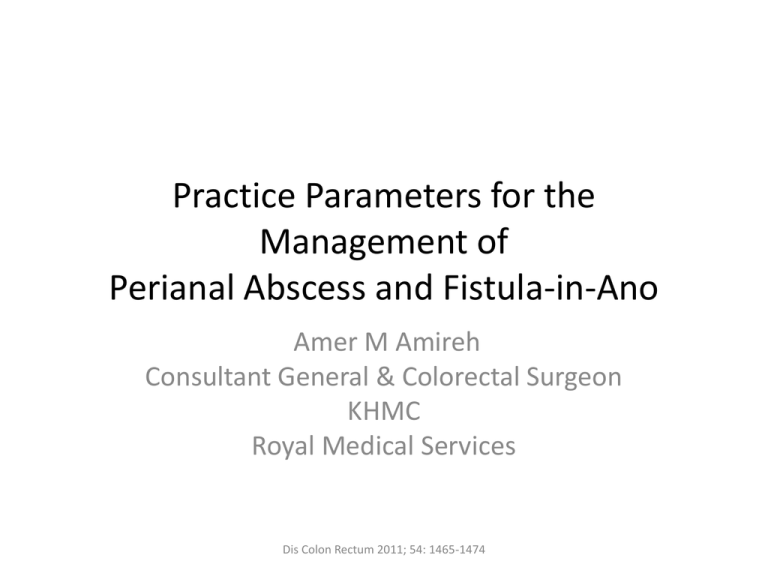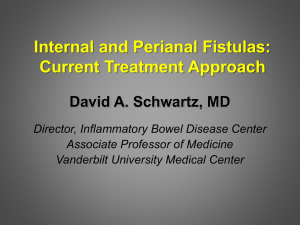
Practice Parameters for the
Management of
Perianal Abscess and Fistula-in-Ano
Amer M Amireh
Consultant General & Colorectal Surgeon
KHMC
Royal Medical Services
Dis Colon Rectum 2011; 54: 1465-1474
Introduction
Perianal Abscess
• Anorectal abscess is a potentially debilitating
condition
• Often originating from a cryptoglandular
infection in the anal canal
• Remains one of the more common anorectal
conditions encountered in practice
• Abscesses are classified into:
–
–
–
–
Perianal
Ischiorectal
Intersphincteric
Supralevator
Dis Colon Rectum 2011; 54: 1465-1474
Anatomical Classification
Dis Colon Rectum 2011; 54: 1465-1474
Introduction
Fistula-in-Ano
• In approximately 30% to 50% of patients with an
anorectal abscess fistula-in-ano, develops
• No definitive way to predict:
– Who will develop one
– Or how to prevent one
• Fistulas are categorized based on their anatomical
course relative to the sphincter complex:
–
–
–
–
Intersphincteric
Transsphincteric
Suprasphincteric
extrasphincteric
Dis Colon Rectum 2011; 54: 1465-1474
Anatomical Classification
Dis Colon Rectum 2011; 54: 1465-1474
Introduction
Fistula-in-Ano
• Fistulas can also be classified as “simple” or “complex”
• Simple fistulas includes:
– Low transsphincteric
– Intersphincteric fistulas that cross 30% of the external sphincter
• Complex fistulas includes:
–
–
–
–
–
High transsphincteric fistulas with or without a high blind tract
Suprasphincteric
Extrasphincteric fistulas
Horseshoe fistulas
Associated with inflammatory bowel disease, radiation,
malignancy, preexisting incontinence, or chronic diarrhea
– Fistulas in the anterior sphincter complex in women may be
considered complex as well.
Dis Colon Rectum 2011; 54: 1465-1474
Simple Fistula
Complex
Horse shoe fistula
Complex Fistula
Crohn’s
Complex Fistula
Malignancy
Complex Fistula
Malignancy
Complex Fistula
Anterior Type Females
Methodology
• These guidelines are built on the last set of the
American Society of Colon and Rectal Surgeons
Practice Parameters for treatment of perianal
abscess and fistula-in-ano published in 2005.
• An organized search of MEDLINE, PubMed,
EMBASE, and the Cochrane Database of Collected
Reviews was performed through February 2010
• The final grade of recommendation was
performed using the Grades of Recommendation,
Assessment, Development, and Evaluation
(GRADE) system
Dis Colon Rectum 2011; 54: 1465-1474
Dis Colon Rectum 2011; 54: 1465-1474
Recommendations
Initial Evaluation of Perianal Abscess and Fistula-in-Ano
Recommendation 1
• Disease-specific history and physical examination should be
performed
– Emphasizing on:
•
•
•
•
•
Symptoms
Risk factors
Location
Presence of secondary cellulitis
Presence of fistula-in-ano
– It is important to distinguish anorectal abscess from other perianal
suppurative processes
– Anoscopy and sigmoidoscopy may be performed
– In general, laboratory evaluation is not necessary
Grade of Recommendation:
Strong recommendation based on low-quality evidence (1C)
Dis Colon Rectum 2011; 54: 1465-1474
Recommendations
Initial Evaluation of Perianal Abscess and Fistula-in-Ano
Recommendation 2
• Radiological studies may be considered in selected patients to help
define the anatomy of an anorectal abscess or fistula-in-ano and to
guide management.
Grade of Recommendation:
• Strong recommendation based on low quality evidence (1C)
– Abscess and fistula-in-ano are most commonly diagnosed and
managed on the basis of clinical findings alone
– Traditionally, fistulography was the method of choice accuracy rates as
low as 16%
– Endoanal ultrasound is very effective accuracy rates 80% to 89%
– Three-dimensional ultrasound techniques provide even better imaging
– CT scan can be useful
– MRI with or without endoanal coils has reported accuracy rates of
more than 90%
Dis Colon Rectum 2011; 54: 1465-1474
Recommendations
Management of Perianal Abscess
Recommendation 1
1. Patients with acute anorectal abscess should be
treated in a timely fashion with incision and
drainage
Grade of Recommendation:
• Strong recommendation based on low quality evidence (1C)
– Keep incision as close as possible
– Adequately sized elliptical incision
– Recurrence rate range between 3%-44%
•
•
•
•
Incomplete initial drainage
Failure to break up loculations
Missed abscess
Undiagnosed fistula
Dis Colon Rectum 2011; 54: 1465-1474
Recommendations
Management of Perianal Abscess (Role of Antibiotics)
Recommendation 2 & 3
2. Antibiotics have a limited role in the treatment of
uncomplicated anorectal abscess:
Grade of Recommendation:
•
Strong recommendation based on moderate quality evidence
(1B)
3. Antibiotics may be considered in patients with
significant:
I.
II.
III.
Cellulitis,
Underlying immunosuppression, or
Concomitant systemic illness
Grade of Recommendation:
•
Weak recommendation based on low-quality evidence (2C)
Dis Colon Rectum 2011; 54: 1465-1474
Fistula-in-Ano
• The goal in the treatment is to obliterate the
fistulous tract with minimal sphincter division
• Thus, it is imperative to identify the internal
opening and the course of all tracts relative to
the sphincter muscles
– the location of the external opening can be a poor
predictor of the location of a fistula especially in:
• long fistula tracts
• recurrent fistulas
• Crohn’s disease
Dis Colon Rectum 2011; 54: 1465-1474
Fistula-in-Ano
• In addition to:
– Direct visualization and
– Palpation
• The surgeon must be familiar with adjunctive intraoperative
measures, including:
– Hydrogen peroxide
– Methylene blue injection
• In addition, the etiology should be determined
–
–
–
–
–
–
Cryptoglandular infection in 80%
Crohn’s
Trauma
Radiation
Malignancy
Infection
Dis Colon Rectum 2011; 54: 1465-1474
Fistula-in-Ano
• Because no single technique is appropriate for the
treatment of all fistulas-in-ano;
• treatment must be directed by the:
–
–
–
–
–
Etiology
Anatomy of the fistula
Degree of symptoms
Patient comorbidities
And the surgeon’s experience
• keep in mind the progressive tradeoff between:
– Extent of operative sphincter division
– Postoperative healing rates
– And functional compromise
Dis Colon Rectum 2011; 54: 1465-1474
Recommendations
Treatment of a Simple Fistula-in-Ano
Recommendation 1
1. Simple anal fistulas may be treated by fistulotomy, the
addition of marsupialization may improve the rate of
wound healing
Grade of Recommendation:
• Strong recommendation based on moderate-quality evidence (1B)
–
–
–
–
How much muscle can be safely divided?
success rates of 92% to 97%
Postoperative alterations in continence in 0%to 73% of patients
Risk factors for incontinence include:
•
•
•
•
Recurrent disease
Female sex
Complex fistulas
Prior fistula surgery
Dis Colon Rectum 2011; 54: 1465-1474
Management of Simple fistula
Management of Simple fistula
Recommendations
Treatment of a Simple Fistula-in-Ano
Recommendation 1
– The addition of marsupialization has also been
associated with:
• less postoperative bleeding
• accelerated wound healing
– Fistulectomy is associated with:
•
•
•
•
Longer healing times
Larger defects
And a higher risk of incontinence
Although recurrence rates are similar when compared
with fistulotomy
Dis Colon Rectum 2011; 54: 1465-1474
Recommendations
Treatment of a Simple Fistula-in-Ano
Recommendation 2
2. Concomitant fistulotomy with incision and drainage
may be considered in select patients with anorectal
abscess and fistula
Grade of Recommendation:
• Weak recommendation based on moderate-quality evidence (2B)
– The utility of fistulotomy in conjunction with incision and
drainage of an anorectal abscess remains controversial
– Recurrence rate is lower but;
– The surgeon should weigh the possible decreased
recurrence rate in light of the potential increased risk of
continence disturbances
Dis Colon Rectum 2011; 54: 1465-1474
Recommendations
Treatment of a Simple Fistula-in-Ano
Recommendation 3
3. Simple anal fistulas may be treated with
debridement and fibrin glue injection
Grade of Recommendation:
• Weak recommendation based on low-quality evidence
(2C)
– Higher failure rate than fistulotomy
– Low rates of incontinence in both groups
Dis Colon Rectum 2011; 54: 1465-1474
Recommendations
Treatment of Complex Fistula-in-Ano
Recommendation 1
1. Complex anal fistulas may be treated with
debridement and fibrin glue injection
Grade of Recommendation:
• Weak recommendation based on low-quality evidence
(2C)
– Although fibrin glue therapy has a relatively low
success rate in complex disease
– Low morbidity associated
– It may be considered for initial therapy.
Dis Colon Rectum 2011; 54: 1465-1474
Recommendations
Treatment of Complex Fistula-in-Ano
Recommendation 2
2. Anal fistula plug may be used for treatment of
complex anal fistula disease
Grade of Recommendation:
• Weak recommendation based on moderate-quality
evidence (2C)
– initial reports demonstrated closure rates of 80% in
patients with Crohn’s; but
– majority of studies reporting <50% success
– Still the low morbidity and lack of other options:
• warrant consideration of this therapy in patients with
complex fistulas
Dis Colon Rectum 2011; 54: 1465-1474
Recommendations
Treatment of Complex Fistula-in-Ano
Recommendation 3
3. Endoanal advancement flaps may be used for
treatment of complex anal fistula disease
Grade of Recommendation:
• Strong recommendation based on moderate- quality
evidence (1C)
– Another sphincter-sparing technique consists of:
• Curettage of the tract
• Mobilizing a segment of proximal healthy anorectal
mucosa, submucosa, and muscle
• Cover the site of the sutured internal opening with the
flap
Dis Colon Rectum 2011; 54: 1465-1474
Advancement flap
Advancement flap
Advancement flap
Recommendations
Treatment of Complex Fistula-in-Ano
Recommendation 3
– Recurrence rates range from 13% to 56%
– Factors associated with failed repair include:
•
•
•
•
•
•
Radiation
Underlying Crohn’s disease,
Active proctitis
Rectovaginal fistula
Malignancy
And number of prior attempted repairs
– Although the sphincter is not divided
• mild or moderate incontinence is still reported in up to 7%–
38% of patients
Dis Colon Rectum 2011; 54: 1465-1474
Recommendations
Treatment of Complex Fistula-in-Ano
Recommendation 4
4. Complex anal fistulas may be treated by the use of a seton
and/or staged fistulotomy
Grade of Recommendation:
• Strong recommendation based on moderate quality evidence (1B)
– The seton will convert an inflammatory process to a foreign
body reaction causing perisphincteric fibrosis
• May be of the cutting type, or
• Loose type
– Loose type; may be left in place long-term or removed with
ultimate cure;
• The initial seton placement is to control sepsis followed by a
secondary procedure
• Success rates ranged from 62% to 100%, depending on the type of
secondary procedure
Dis Colon Rectum 2011; 54: 1465-1474
Complex Fistula
Seton
Recommendations
Treatment of Complex Fistula-in-Ano
Recommendation 4
– Changes in continence range from 0% to 54% with
patients undergoing 2-staged procedures or
cutting setons
– Finally in sepsis recalcitrant to other methods
diversion and appropriate drainage may be
required
Dis Colon Rectum 2011; 54: 1465-1474
Recommendations
Treatment of Complex Fistula-in-Ano
Recommendation 5
5. Complex fistulas may be treated with ligation of the
intersphincteric fistula tract (LIFT)
Grade of Recommendation:
• No recommendation
– A relatively new technique
– Involves ligation and division of the fistula tract in the
intersphincteric space
– few small series to date in the literature
– successful closure has been reported in 57% to 94% at a mean
follow-up of 3 to 8 months
– with a recurrence rate of 6% to 18%
– no major changes in continence or morbidity
– data are too preliminary to make a formal recommendation
Dis Colon Rectum 2011; 54: 1465-1474
Complex Fistula
LIFT Procedure
Complex Fistula
LIFT Procedure
Complex Fistula
LIFT Procedure
Treatment of Perianal Fistula Associated With
Crohn’s Disease
• Perianal pathology occurs in 40% to 80% of patients with Crohn’s
disease
• The primary treatment for perianal Crohn’s fistulas is medical
• Surgery is reserved for the control of sepsis
• And occasionally as an adjunct for cure
• Antibiotics are effective, especially in fistulizing disease in over 90%
of patients
• Infliximab has been shown to increase the healing rate of perianal
fistulas
– With complete closure in up to 46% of patients
– The decision to embark on surgical treatment for perianal Crohn’s
disease must be
• Individualized
• And based on the extent of disease and the severity of symptoms
Dis Colon Rectum 2011; 54: 1465-1474
Recommendations
Treatment of Perianal Fistula Associated With
Crohn’s Disease
1. Asymptomatic fistulas in patients with Crohn’s
disease do not require surgical treatment
Grade of Recommendation:
•
Strong recommendation based on lowquality evidence
(1C)
2. Symptomatic simple low Crohn’s fistulas may be
treated by fistulotomy
Grade of Recommendation:
•
Strong recommendation based on lowquality evidence
(1C)
Dis Colon Rectum 2011; 54: 1465-1474
Recommendations
Treatment of Perianal Fistula Associated With
Crohn’s Disease
3. Complex Crohn’s fistulas may be well palliated
with long-term draining setons
Grade of Recommendation:
•
Strong recommendation based on lowquality evidence
(1C)
4. Complex Crohn’s fistulas may be treated with
advancement flap closure if the rectal mucosa is
grossly normal
Grade of Recommendation:
•
Weak recommendation based on low-quality evidence
(2C)
Dis Colon Rectum 2011; 54: 1465-1474
Recommendations
Treatment of Perianal Fistula Associated With
Crohn’s Disease
5. Complex Crohn’s fistulas may require
permanent diversion or proctectomy for
uncontrollable symptoms
Grade of Recommendation:
•
Strong recommendation based on lowquality
evidence (1C)
Dis Colon Rectum 2011; 54: 1465-1474
Procedures for Perianal Fistulae
done by the Colo Rectal Team
at KHMC in the year 2011
Seton Stitch
52 cases
Advancement Flap
18 cases
LIFT
3 cases
Fistulotomy
19 cases
Fistulectomy
7 cases
Fibrin glue
1 case
Total
100 case
Thank you
Questions?





